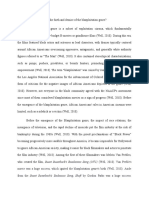Popculture 1
Popculture 1
Uploaded by
api-215889512Copyright:
Available Formats
Popculture 1
Popculture 1
Uploaded by
api-215889512Original Title
Copyright
Available Formats
Share this document
Did you find this document useful?
Is this content inappropriate?
Copyright:
Available Formats
Popculture 1
Popculture 1
Uploaded by
api-215889512Copyright:
Available Formats
Pop Culture Portrayal of African-Americans
Academic Paper #2
By Jonathan Aaron Clark 3/13/2013 COMM 2150 SEC 001
Does art imitate life or does life imitate art? This rhetorical question just about sums up the effect and confusion that popular culture has on our country and the way we think and interpret social trends. One only has to watch a few hours of television to get an idea of what is popular and hip today but it begs the question of whether or not it truly represents the attitudes and trends of society. Popular culture is best represented today through television and movies. The question is just how accurate and fair is that representation and does it negatively affect attitudes of those who consume this type of popular culture? Television has changed over the years in both the levels of choice and content due in part to the expansion of televisions reach through cable and satellite. Before the days of HBO and FX the public was limited in choice to whatever programming stations like NBC, CBS, and ABC would offer. The level of control and the type of culture that was being presented was evident in the many family type offerings that were being represented in television shows. From Leave it to Beaver to Full House, the public was subjected to decades of shows dedicated to showing the problems of white, middle class America. Though it could be argued that due to the high ratings of those type of shows that this is exactly what America wanted to see and associated the best with, it was likely simply due to a lack of choice. The lack of programming choices often left minorities that were not part of the white middle class feeling left out and at best misrepresented. In the textbook Communications in Contexts (1) it references how African American women were portrayed stereotypically on TV, specifically in the 1950s and 1960s, when the roles they held were secondary. Scholar Bishetta Merritt reminds us that African American female characters often appeared as people buying drugs, homeless and destitute, and as prostitutes. This of course was a misrepresentation of African American woman and white women were not shown in a similar light. Rather white women were generally portrayed as the happy, organized housewife, quite often the voice of reason in most shows. This was a dangerous trend that led to inaccurate and negative attitudes. In the textbook Communications in Contexts (2) Film studies scholar Richard Dyer tells us that
the effectiveness of stereotypes resides in the way the invoke a consensus...the stereotype is taken to express a general agreement about a social group This type of popular culture in the form of television was detrimental to cultural attitudes. However with the expansion of cable and satellite television we now have a much more diverse offering of channels and are no longer held hostage to whatever the major networks want to show. Cable channels like BET and Spike TV show a more diverse and accurate side of African American culture and offer a better representation of what African American roles in society really are. The major network channels have seen the popularity of minority infused shows and their programming options have dramatically changed from the days of Full House where a minority was a curious entity that was more than a sideshow. Today popular culture is more accurately reflected in television and gives credibility to those who would say that art imitates life. Hollywood has also had a negative effect with popular culture through movies with the same type of stereotypes and misconceptions being inserted in movies during the same era when television was limited in choice. What was most damning about the how long it took for the film industry to adapt to was the fact there has always been a wide choice of movies available to the public. Despite that the film industry continued to show films that portrayed blacks in demeaning roles for far longer that it should have. Ever since its inception, the cinema has influenced the way moviegoers view life. This was an especially powerful reality in early Hollywood films, which depicted their own interpretation of social mores and moral proclivities to mesmerized, largely naive audiences who accepted what they saw on the screen as truth. Hollywood began to become a force around or after 1910. During this era, racism and prejudicial concepts of African-Americans was the status quo in much of the United States. It was of no surprise, then, that these stilted viewpoints would be transferred over into the films produced by movie studios. Much like television the portrayal of African-Americans in the movies created a negative and inaccurate pop culture specifically
with Hollywood using white actors to play darker skinned characters as blackface. This was a contributing factor to the pop culture of the time that insinuated that African-Americans were nothing more than submissive servants. Eventually the use of blackface was discontinued due to calls of bigotry and racism but the damage was done. Even as African-American actors began to rise in stature the film industry refused to acknowledge the roles of black actors at the Academy Awards. Many within the industry speculate that it was because most of the Academy voters were older, white men. However the lack of acknowledgement to the many talents of the African-American actor helped to build a culture of thinking that white people were better actors. It seems as though unless the African American actors and actresses are willing to bend to Hollywood pressures they will not be acknowledged by the Academy, "Sidney Poitier originally turned down the role of Porgy in the 1959 film (calling it 'not material complimentary to black people')", but eventually succumbed to Hollywood pressure. Years later, Sidney Poitier received an honorary 2010 Academy Award for helping to "dismantle the color line in film (3) During that era it was definitely a case of life imitating art as those type of roles and lack of accolades for the African-American actor led to a false sense of what African-American were and what they are capable of in the eyes of the viewer both black and white. However times have started to slowly change in the film industry and we are finally starting to see examples of art imitating life thanks to such prominent African-American director such as Spike Lee and Tyler Perry. Both directors have found favor with Hollywood by showing the powers that be that making a film that is both true to the culture and targeted towards a black audience could be profitable and in Hollywood money talks.
Although it took almost a century even Disney caught up with the turning tide of a pop culture that was starting to accurately portray African-Americans. In 2009 Disney released the animated film The Princess and the Frog that for the first time in Disney history starred a black princess
named Taina. With that film many people began to believe that that the color barrier is breaking down in Hollywood. (4) For many African-Americans this represented a long awaited break through in black pop culture because it meant that prominent black characters didnt have to exist only in a Spike Lee or Tyler Perry movie targeted towards blacks. It showed that a black character could be targeted to a mainstream audience, the true test of pop culture and a sign that truly art was finally imitating life when it came to African-Americans. Although its a travesty that change has taken as long as it has in regards to how AfricanAmericans are portrayed through pop culture the times are changing and they are changing fast. A majority of people may still see the thin line between Hollywood's "new" attitude toward race and their "old" attitude toward race. The consolidation of a black presence in the movies and television did not signal the arrival of a post racial Hollywood any more than the election of Barack Obama in 2008 spelled the end of Americas 400-year-old racial drama. (5) However change occurs at a slower and often hypocritical pace when it comes to minority groups as the majority groups are slow to let go of their power. This trend of diverse pop culture will continue to flourish as Hollywood continues to see there is money to be made, and this is how society gets to art finally imitating life.
References
(1) Communications in Contexts by Judith N. Martin and Thomas K. Nakayama (pg. 374)
(2) Communications in Contexts by Judith N. Martin and Thomas K. Nakayama (pg. 373)
(3) Dargis, Manohla (11 February 2011). "Hollywood Whiteout". The New York Times. Retrieved 25 April 2012.
(4) Barnes, Brooks (19 October 2008). "Race and the safe Hollywood Bet". The New York Times. Retrieved 25 April 2012.
(5) Dargis, Manohla (11 February 2011). "Hollywood Whiteout". The New York Times. Retrieved 25 April 2012.
You might also like
- Todd Boyd - African Americans and Popular Culture (3 Vol Set) (2008, Praeger)Document834 pagesTodd Boyd - African Americans and Popular Culture (3 Vol Set) (2008, Praeger)Gabriel Viana SilveiraNo ratings yet
- Employees Satisfaction and Quality of Work Life at Tata SteelDocument84 pagesEmployees Satisfaction and Quality of Work Life at Tata SteelSwati Sharma100% (5)
- A Comparative Study On The Depiction of racism:BlacK Klansman, A Memoir by Ron Stallworth and BlacKkKlansman The Movie by Spike LeeDocument49 pagesA Comparative Study On The Depiction of racism:BlacK Klansman, A Memoir by Ron Stallworth and BlacKkKlansman The Movie by Spike LeeFathima FrancisNo ratings yet
- Final PaperDocument7 pagesFinal Paperapi-354218331No ratings yet
- African Americans in AnimationDocument7 pagesAfrican Americans in Animationapi-460274999No ratings yet
- NAACP's Out of Focus, Out of Sync Take 3: A Report On The Film and Television Industry (November 2003)Document52 pagesNAACP's Out of Focus, Out of Sync Take 3: A Report On The Film and Television Industry (November 2003)Mr Alkebu-lan100% (1)
- Minority Representation in Television and Motion Pictures: Nina Boggan CAP 9 2016Document11 pagesMinority Representation in Television and Motion Pictures: Nina Boggan CAP 9 2016NinaNo ratings yet
- Whitewashing Vs Racebending: What, Why, When and How?Document4 pagesWhitewashing Vs Racebending: What, Why, When and How?yasmin3961No ratings yet
- Media Influences PaperDocument6 pagesMedia Influences Papersec0488No ratings yet
- Pop Culture ReadingDocument10 pagesPop Culture ReadingnguyenhaichinguyenhaichiNo ratings yet
- Reflection Paper Gah 3207 FinalDocument4 pagesReflection Paper Gah 3207 Finalapi-535285039No ratings yet
- CWP Final Paper PDFDocument12 pagesCWP Final Paper PDFJaylan SnaithNo ratings yet
- DiversityDocument3 pagesDiversityMikori ChanNo ratings yet
- Draft 2Document18 pagesDraft 2api-706186416No ratings yet
- Final PodcastDocument5 pagesFinal Podcastapi-459631554No ratings yet
- Essay 2 White ChicksDocument6 pagesEssay 2 White Chicksapi-2427608140% (1)
- Project33 2Document5 pagesProject33 2api-356874096No ratings yet
- I Am Who I Am'': Black Masculinity and The Interpretation of Individualism in The Film BarbershopDocument16 pagesI Am Who I Am'': Black Masculinity and The Interpretation of Individualism in The Film BarbershopashrafalhabsyNo ratings yet
- Scratchin' and Survivin': Hustle Economics and the Black Sitcoms of Tandem ProductionsFrom EverandScratchin' and Survivin': Hustle Economics and the Black Sitcoms of Tandem ProductionsNo ratings yet
- Module 4Document18 pagesModule 4expertcomputer514No ratings yet
- Media Minority PotrayalsDocument7 pagesMedia Minority PotrayalsBrymak BryantNo ratings yet
- Cultural Impact by Friends TV Show - EditedDocument3 pagesCultural Impact by Friends TV Show - EditedDavid JumaNo ratings yet
- Jerrell Mobley Eip-FinalDocument10 pagesJerrell Mobley Eip-Finalapi-340117042No ratings yet
- How The Media Affects UsDocument1 pageHow The Media Affects Us조명진No ratings yet
- WRTC 608 SeminarpaperDocument17 pagesWRTC 608 Seminarpaperapi-284585821No ratings yet
- Diversity in Media Engl 1302 Annotated BibliographyDocument6 pagesDiversity in Media Engl 1302 Annotated Bibliographyapi-703846323No ratings yet
- Cultural WarsDocument4 pagesCultural Warsapi-331341270No ratings yet
- Black American Portrait EssayDocument4 pagesBlack American Portrait EssayJessica NguyenNo ratings yet
- Performing African American Womanhood: Hazel Scott and The Politics of Image in WWII AmericaDocument16 pagesPerforming African American Womanhood: Hazel Scott and The Politics of Image in WWII AmericaInternational Journal of Transpersonal StudiesNo ratings yet
- Hollywood Goes Oriental: Caucasian Performance in American FilmFrom EverandHollywood Goes Oriental: Caucasian Performance in American FilmNo ratings yet
- Final Research LogsDocument10 pagesFinal Research Logsapi-540582850No ratings yet
- Black Voices From Spike Lee To RapDocument2 pagesBlack Voices From Spike Lee To Rapjulia_kissNo ratings yet
- The Jews of Prime TimeDocument18 pagesThe Jews of Prime Timednjmdm5gdkNo ratings yet
- AB1-Jacob LoDocument4 pagesAB1-Jacob LoJacob LoNo ratings yet
- Who Gets To Cry?Document8 pagesWho Gets To Cry?Cassius DeDragonNo ratings yet
- Stereotyping and The Problematics in Foreign Language TeachingDocument16 pagesStereotyping and The Problematics in Foreign Language TeachingArushi GuptaNo ratings yet
- Krenik - Academic Essay MA70079ODocument7 pagesKrenik - Academic Essay MA70079OAnnie KrenikNo ratings yet
- Adriel Macias MediaDocument4 pagesAdriel Macias Mediaapi-272139384No ratings yet
- Jomc Mass Com ResearchDocument6 pagesJomc Mass Com ResearchMorgan HaythorneNo ratings yet
- Hollywood's Gender Diversity Problem: Past, Present, and FutureDocument9 pagesHollywood's Gender Diversity Problem: Past, Present, and FutureCassandra ClarkNo ratings yet
- The Riverdale ConundrumDocument10 pagesThe Riverdale ConundrumMichael Kevin MangaoNo ratings yet
- Ms C CommentsDocument13 pagesMs C CommentsGerome Romeo CheekNo ratings yet
- Debate: Impact On Society of MoviesDocument4 pagesDebate: Impact On Society of Moviesrahulyadav18No ratings yet
- Asia Allen: The House We Live In-Assignment #4Document4 pagesAsia Allen: The House We Live In-Assignment #4Asia AllenNo ratings yet
- Positive, Negative and Interrogative Imagines of African Americans On FilmDocument54 pagesPositive, Negative and Interrogative Imagines of African Americans On Filmnylah.aminaNo ratings yet
- American Cinema American CultureDocument7 pagesAmerican Cinema American CultureSyed Faisal MahmoodNo ratings yet
- Gilroy: CinemaDocument14 pagesGilroy: CinemabrtyNo ratings yet
- A Book Review - What We Really Miss About 1950sDocument7 pagesA Book Review - What We Really Miss About 1950sTai LamNo ratings yet
- Misrepresentation and Representation in The Media 2Document14 pagesMisrepresentation and Representation in The Media 2api-528889036No ratings yet
- Race and Ethnicity in American CinemaDocument2 pagesRace and Ethnicity in American CinemawellioiNo ratings yet
- Commonlit Cultural Common Ground Gets Harder To Come by StudentDocument5 pagesCommonlit Cultural Common Ground Gets Harder To Come by StudentHuynh Ngoc An ViNo ratings yet
- How Does Pleasantville Use Satire To Comment On Social IssuesDocument3 pagesHow Does Pleasantville Use Satire To Comment On Social IssuesHope MarieNo ratings yet
- From Mantan Moreland To Denzel Washington: The Struggle For Positive Representation of African-Americans in FilmDocument8 pagesFrom Mantan Moreland To Denzel Washington: The Struggle For Positive Representation of African-Americans in FilmG WelchNo ratings yet
- Dear White People EssayDocument8 pagesDear White People EssayErin Sullivan100% (1)
- America's Cultural Role in The World TodayDocument4 pagesAmerica's Cultural Role in The World TodayErikaNo ratings yet
- Media Representation of Minority Groups EditedDocument5 pagesMedia Representation of Minority Groups EditedjulietmbayajiNo ratings yet
- White Negroes: When Cornrows Were in Vogue . and Other Thoughts on Cultural AppropriationFrom EverandWhite Negroes: When Cornrows Were in Vogue . and Other Thoughts on Cultural AppropriationRating: 4 out of 5 stars4/5 (13)
- Turn It inDocument3 pagesTurn It inJim HuNo ratings yet
- Student DiversityDocument49 pagesStudent DiversityBhaskar TupteNo ratings yet
- Administrative ManagementDocument2 pagesAdministrative ManagementbabluanandNo ratings yet
- Trafalgar Place - CEMPDocument38 pagesTrafalgar Place - CEMPBermondsey Bill OwenNo ratings yet
- A Practice of Corporate Social Responsibility (CSR)Document11 pagesA Practice of Corporate Social Responsibility (CSR)Leslie Monica MacaisaNo ratings yet
- Securitisation and Reconstruction of Financial Assets and Enforcement of Security Interest Act, 2002 (Sarfaesi Act)Document18 pagesSecuritisation and Reconstruction of Financial Assets and Enforcement of Security Interest Act, 2002 (Sarfaesi Act)varun100% (1)
- How Aleister Crowley Came To BerkeleyDocument3 pagesHow Aleister Crowley Came To BerkeleyYan PetroffNo ratings yet
- Analysis of The Implementation of Effective Waste Management Practices in Construction Projects and SitesDocument13 pagesAnalysis of The Implementation of Effective Waste Management Practices in Construction Projects and Sitesjcaldanab100% (1)
- Tau Human AuxileriesDocument2 pagesTau Human Auxileriessinisterbutt100% (4)
- Integrantes:: Universidad Nacional Mayor de San MarcosDocument14 pagesIntegrantes:: Universidad Nacional Mayor de San MarcosVance GonzalezNo ratings yet
- Afar 2 LQ T2Document14 pagesAfar 2 LQ T2Alexandria EvangelistaNo ratings yet
- The King and IDocument2 pagesThe King and ICarl Denver BaccayNo ratings yet
- Judicial Applications of Artificial IntelligenceDocument36 pagesJudicial Applications of Artificial IntelligencenovisadNo ratings yet
- Stw45Nm60: N-Channel 650V@Tjmax - 0.09 - 45A - To-247 Mdmesh™ Power MosfetDocument12 pagesStw45Nm60: N-Channel 650V@Tjmax - 0.09 - 45A - To-247 Mdmesh™ Power MosfetYani RiyaniNo ratings yet
- Chapter L-WPS OfficeDocument12 pagesChapter L-WPS OfficeFloresa TahumNo ratings yet
- Mil STD 361 - 11Document63 pagesMil STD 361 - 11veyevay452No ratings yet
- Definition:-: Micro, Small and Medium EnterpricesDocument3 pagesDefinition:-: Micro, Small and Medium EnterpricesSampath BanalaNo ratings yet
- How To Calculate Car InterestDocument1 pageHow To Calculate Car InterestKevinNo ratings yet
- 350 Câu Hỏi Trọng Âm Định KỳDocument12 pages350 Câu Hỏi Trọng Âm Định KỳTrang NguyễnNo ratings yet
- A Synopsis of English Syntax PDFDocument310 pagesA Synopsis of English Syntax PDFal mooreNo ratings yet
- Organ Recital - Octave of Easter 2021 - BrakelDocument12 pagesOrgan Recital - Octave of Easter 2021 - BrakelMusLitNo ratings yet
- The Cask of AmontilladoDocument3 pagesThe Cask of AmontilladocrazybobblaskeyNo ratings yet
- Exit Interview QuestionnaireDocument3 pagesExit Interview Questionnairesavan kalakarNo ratings yet
- Ace 152190 R 0000583613Document65 pagesAce 152190 R 0000583613derpmilitantNo ratings yet
- One Hundred and Fifty Years of Nahuatl Decipherment, by Marc ZenderDocument15 pagesOne Hundred and Fifty Years of Nahuatl Decipherment, by Marc ZenderMuzen Der100% (1)
- GST On E-Commerce OperatorsDocument45 pagesGST On E-Commerce OperatorsSai Kiran KudavalliNo ratings yet
- Kuber PoojaDocument3 pagesKuber PoojaHarsh SoroutNo ratings yet
- HaroldDocument3 pagesHaroldDakshayane MunandyNo ratings yet
- Contract of Lease 07-22-2021 NewDocument2 pagesContract of Lease 07-22-2021 Newgabriella shintaine dominique dilayNo ratings yet
- Nike Strategic Planning DocumentDocument37 pagesNike Strategic Planning DocumentJohn Paolo BelloNo ratings yet

























































































